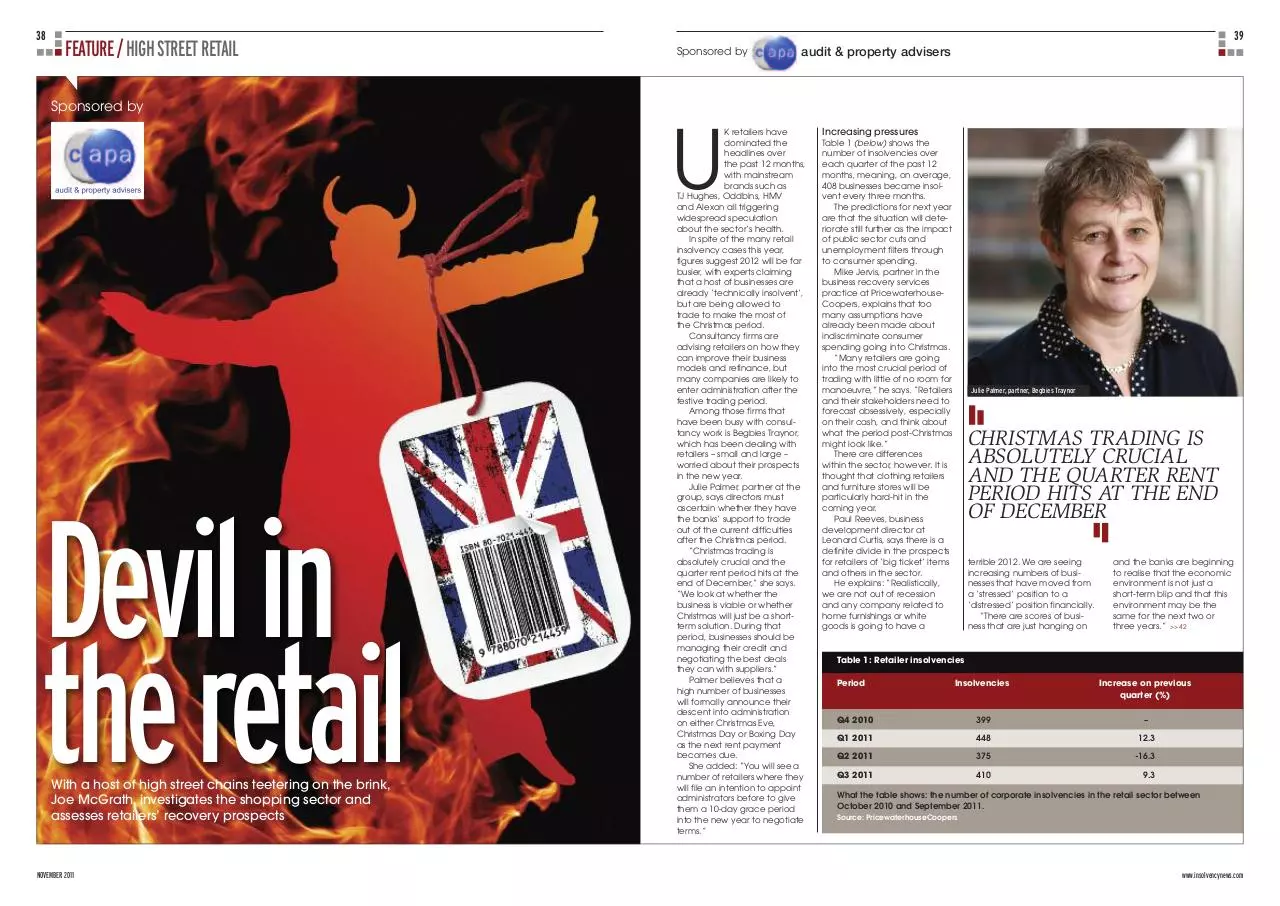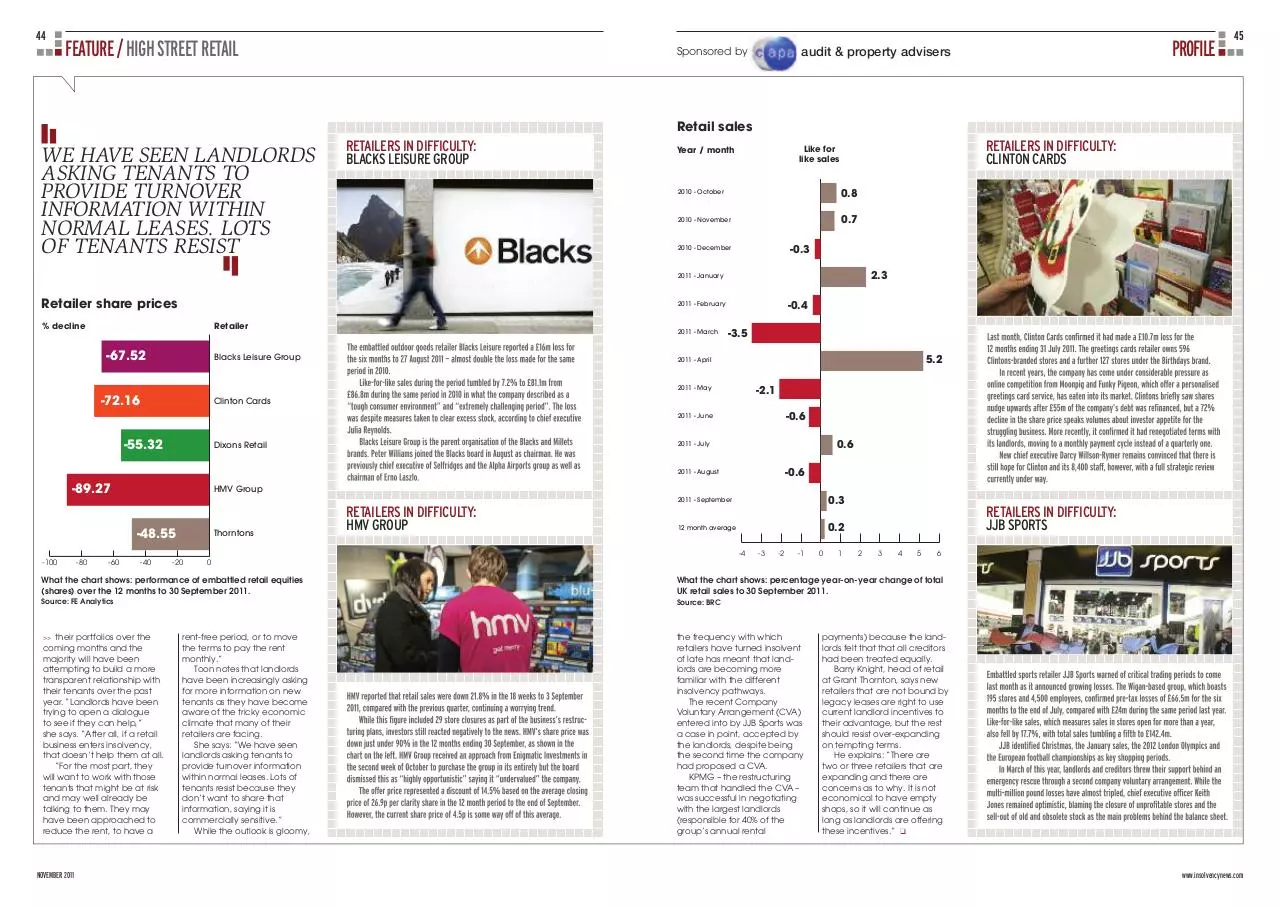Devil in the retail (PDF)
File information
Title: Layout 1
This PDF 1.4 document has been generated by QuarkXPress(R) 8.02, and has been sent on pdf-archive.com on 09/01/2012 at 11:13, from IP address 87.86.x.x.
The current document download page has been viewed 1002 times.
File size: 754.23 KB (3 pages).
Privacy: public file



File preview
38
FEATURE / HIGH STREET RETAIL
39
Sponsored by
audit & property advisers
Sponsored by
U
Devil in
the retail
With a host of high street chains teetering on the brink,
Joe McGrath, investigates the shopping sector and
assesses retailers’ recovery prospects
NOVEMBER 2011
K retailers have
dominated the
headlines over
the past 12 months,
with mainstream
brands such as
TJ Hughes, Oddbins, HMV
and Alexon all triggering
widespread speculation
about the sector’s health.
In spite of the many retail
insolvency cases this year,
figures suggest 2012 will be far
busier, with experts claiming
that a host of businesses are
already ‘technically insolvent’,
but are being allowed to
trade to make the most of
the Christmas period.
Consultancy firms are
advising retailers on how they
can improve their business
models and refinance, but
many companies are likely to
enter administration after the
festive trading period.
Among those firms that
have been busy with consultancy work is Begbies Traynor,
which has been dealing with
retailers – small and large –
worried about their prospects
in the new year.
Julie Palmer, partner at the
group, says directors must
ascertain whether they have
the banks’ support to trade
out of the current difficulties
after the Christmas period.
“Christmas trading is
absolutely crucial and the
quarter rent period hits at the
end of December,” she says.
“We look at whether the
business is viable or whether
Christmas will just be a shortterm solution. During that
period, businesses should be
managing their credit and
negotiating the best deals
they can with suppliers.”
Palmer believes that a
high number of businesses
will formally announce their
descent into administration
on either Christmas Eve,
Christmas Day or Boxing Day
as the next rent payment
becomes due.
She added: “You will see a
number of retailers where they
will file an intention to appoint
administrators before to give
them a 10-day grace period
into the new year to negotiate
terms.”
Increasing pressures
Table 1 (below) shows the
number of insolvencies over
each quarter of the past 12
months, meaning, on average,
408 businesses became insolvent every three months.
The predictions for next year
are that the situation will deteriorate still further as the impact
of public sector cuts and
unemployment filters through
to consumer spending.
Mike Jervis, partner in the
business recovery services
practice at PricewaterhouseCoopers, explains that too
many assumptions have
already been made about
indiscriminate consumer
spending going into Christmas.
“Many retailers are going
into the most crucial period of
trading with little of no room for
manoeuvre,” he says. “Retailers
and their stakeholders need to
forecast obsessively, especially
on their cash, and think about
what the period post-Christmas
might look like.”
There are differences
within the sector, however. It is
thought that clothing retailers
and furniture stores will be
particularly hard-hit in the
coming year.
Paul Reeves, business
development director at
Leonard Curtis, says there is a
definite divide in the prospects
for retailers of ‘big ticket’ items
and others in the sector.
He explains: “Realistically,
we are not out of recession
and any company related to
home furnishings or white
goods is going to have a
Julie Palmer, partner, Begbies Traynor
CHRISTMAS TRADING IS
ABSOLUTELY CRUCIAL
AND THE QUARTER RENT
PERIOD HITS AT THE END
OF DECEMBER
terrible 2012. We are seeing
increasing numbers of businesses that have moved from
a ‘stressed’ position to a
‘distressed’ position financially.
“There are scores of business that are just hanging on
and the banks are beginning
to realise that the economic
environment is not just a
short-term blip and that this
environment may be the
same for the next two or
three years.” >> 42
Table 1: Retailer insolvencies
Period
Insolvencies
Increase on previous
quarter (%)
Q4 2010
399
–
Q1 2011
448
12.3
Q2 2011
375
-16.3
Q3 2011
410
9.3
What the table shows: the number of corporate insolvencies in the retail sector between
October 2010 and September 2011.
Source: PricewaterhouseCoopers
www.insolvencynews.com
42
FEATURE / HIGH STREET RETAIL
Sponsored by
Table 2: Retailers at risk
Month
Total
MoM %
increase
November (2010)
7806
–
December (2010)
7682
-1.6
January (2011)
7643
-0.5
February (2011)
7911
3.5
March (2011)
8250
4.3
April (2011)
8369
1.4
May (2011)
8326
-0.5
June (2011)
8407
1
>> Reeves’ opinions are
supported by a series of
statistical reports. Figures
released by KPMG for the
five weeks until the 1 October
2011, showed consumers are
cutting back on non-essential
spending, with clothing sales
showing their largest year on
year fall since August 2009.
During the same period,
furniture sales fell further below
levels witnessed in the same
period of 2010. The aforementioned ‘big ticket’ items such
as fitted kitchens showed a
decline, which comes after a
massive year on year drop
during the previous year’s
report.
Festive struggle
July (2011)
8650
2.9
August (2011)
8772
1.4
September (2011)
8890
1.3
October (2011)
8896
0.1
Average
8300
1.2
What the table shows: the number of companies showing
a ‘distressed’ balance sheet as at the end of each month.
Source: RSM Tenon
A LOT OF RETAILERS ARE
SAYING THEY ARE GOING
THROUGH THE WORST
RECESSION SINCE THE
SECOND WORLD WAR
Table 2 (left) better demonstrates consumer attitudes in
the current climate, with the
figures illustrating spending
trends, as measured in a
Mintel report.
With more than half of the
1,403 individuals surveyed
agreeing that they are now
spending less than they used
to, it is clear why many high
street retailers started their
autumn sales early this year;
with most agreeing they will
start their New Year sales
early too.
Nigel Yates, investment
fund manager at NFU Mutual,
says some retailers have
underestimated how bad this
Christmas trading period could
actually be. “Christmas could
be tricky,” he says. “If you look
at the market town high
streets, companies are really
struggling.”
However, Yates offers some
comfort, suggesting that
clothing retailers may see a
slight change of fortunes in
2012 as cotton prices come
down, leading to improving
margins. He also notes that
there is unlikely to be a rise in
fuel costs, so inflation could
fall further and the government may yet act to ease
consumers’ personal tax
burdens by increasing the
personal allowance.
But Barry Knight, head of
retail at the accountant
Grant Thornton, says too
many retailers are blaming
their underperformance on
the economic conditions
alone. He says retailers need
to ensure that their business
models are still fit for purpose.
He explains: “My concern is
that a lot of retailers are saying
they are going through the
worst recession since the
second world war and believe
things are going to turn around
but there is a certain amount
of denial that their marketplaces have changed a lot
during the recession.
“They need to consider
digitalisation. Clinton Cards
and Moonpig.com are prime
examples of a business model
that has fundamentally
changed.”
There are a number of
metrics that can be used to
determine whether a retailer is
experiencing difficulties or not.
Heavy or premature
discounting is one of the signs.
It can suggest that a retailer is
panicking, although in annual
or interim results, it may be
justified as a tool to increase
market share.
To determine whether
this is the case or not, look
for retailers that have led a
market into the sale period
or started discounting a long
way ahead of where they did
during the previous year.
PwC’s Mike Jervis says there
are likely to be a large number
of retailers discounting early
this year.
He explains: “There are a
number of retailers we know
of whose cash flow will require
discounting earlier than
December. This time last year,
there was more confidence
around and people were not
as fearful of a double dip
recession. There was less
insecurity about jobs.”
Credit insurers are another
place to look for hints. Like it or
not, rumours and announcements from credit insurers do
have an impact on how a
retail business is perceived.
Therefore, if a company’s
financial situation appears
perilous, credit insurers may cut
back or withdraw the level of
cover being offered to their
suppliers. As seen with the
entertainment group HMV, this
PROFILE
audit & property advisers
Table 3: Consumer spending attitudes
Statement
%
Spending less than they used to
51
Buying more discounted / sale items
35
Waiting for the sales
34
Price tag is the first thing considered
33
Green / ethical issues are irrelevant
14
Easier to control spending in-store
14
Designer clothing is worth the money
8
What the table shows: percentage of people agreeing
with a statement, based on a sample group of 1,403 adults
who have bought clothes in the past 12 months.
Source: Mintel Group
can put enormous pressure on
a business.
When it comes to spotting
red flags, changes in the
directorate are common in
businesses experiencing
difficulties. The media will
concentrate on the appointment of a new chief executive
or chairman, but the finance
director or chief finance officer
are much closer to the action,
so a move there can be more
indicative of problems. If they
have decided to jump ship,
look at their reasons: if the
reasons seem dubious,
chances are they wanted out
Table 4: Projected void rates for commercial premises
Year
%
2004
6.6
2005
6.8
% Change
3.0
2006
7
2.9
2007
8
14.3
2008
9
12.5
2009
10.5
16.7
2010
11.2
6.7
2011
11.3
0.9
2012
11.7
3.5
2013
11.9
1.7
2014
11.5
-3.4
What the table shows: percentage of shops vacant on UK
high streets.
Source: BCSC / Oxford Economics
because they know what is
around the corner.
It is worth keeping an eye
on smaller companies within
a sector – when a sector is in
difficulty, small businesses tend
to suffer disproportionately
to their larger rivals. This is
particularly true in the retail
sector. If you see a large,
national, furniture retailer in
difficulty, you can guarantee
that everyone else in the
sector is too.
Finally, listed companies
will have an obligation to
inform investors that they are
changing how they pay their
landlords. If they move
from quarterly to monthly
payments, there will be a
record of it on the London
Stock Exchange announcements page. Clinton Cards
recently announced it was
moving from quarterly to
monthly rental payments.
Table 3 (left) shows a
breakdown of those retailers
that are at risk of entering
administration based on their
balance sheet alone. While
the figures are only up until
October, they show a clear
positive correlation over the
past 12 months, suggesting
that more businesses will experience difficulties in the early
part of 2012.
43
Kathy Toon, Martineau Group
LANDLORDS
HAVE BEEN
TRYING TO
OPEN A
DIALOGUE
TO SEE IF
THEY CAN
HELP
Landlords and rentals
Table 4 (left) shows the past,
current and projected void
rates for retail premises based
in high streets around the UK,
including London and the
South East.
Over the past three years,
high street property void rates
have gone from 9% to 11.3%,
which illustrates the significant
impact a reduction in
consumer spend has had
indirectly on landlords.
Richard Akers, president
of the British Council of
Shopping Centres (BCSC),
says boarded up shops are
the most prominent symptom
of the plight of some town
centres.
“The problem, while clearly
exacerbated by the economic
downturn, is a structural one,”
he says. “UK business rates
must be urgently reviewed if
retail businesses are to
survive and compete with
rising online sales on an even
footing.
“Likewise, the imposition
of empty rates on even the
smallest properties is
hindering owners’ investment in their properties and
their ability to work with town
centre managers in developing centres that meet
residents’ needs.”
With the number of voids
rising by an average of 8.1%
every year since 2004, it is
perhaps no surprise to hear
landlords are now more
willing to renegotiate terms
than they have been at any
time over the past decade.
Kathy Toon, head of retail
at Birmingham-based law
firm Martineau Group, says
landlords will be scrutinising >>
Barry Knight, Grant Thornton
NOVEMBER 2011
www.insolvencynews.com
44
FEATURE / HIGH STREET RETAIL
PROFILE
audit & property advisers
Sponsored by
45
Retail sales
WE HAVE SEEN LANDLORDS
ASKING TENANTS TO
PROVIDE TURNOVER
INFORMATION WITHIN
NORMAL LEASES. LOTS
OF TENANTS RESIST
RETAILERS IN DIFFICULTY:
BLACKS LEISURE GROUP
RETAILERS IN DIFFICULTY:
CLINTON CARDS
Like for
like sales
Year / month
2010 - October
0.8
2010 - November
0.7
-0.3
2010 - December
2.3
2011 - January
Retailer share prices
-0.4
2011 - February
% decline
Retailer
-67.52
2011 - March
Blacks Leisure Group
-3.5
5.2
2011 - April
2011 - May
-72.16
-2.1
Clinton Cards
-0.6
2011 - June
-55.32
0.6
2011 - July
Dixons Retail
-0.6
2011 - August
-89.27
HMV Group
RETAILERS IN DIFFICULTY:
HMV GROUP
-48.55
Thorntons
2011 - September
0.3
12 month average
0.2
-4
-100
-80
-60
-40
-20
-3
-2
-1
0
1
RETAILERS IN DIFFICULTY:
JJB SPORTS
2
3
4
5
6
0
What the chart shows: performance of embattled retail equities
(shares) over the 12 months to 30 September 2011.
What the chart shows: percentage year-on-year change of total
UK retail sales to 30 September 2011.
Source: FE Analytics
Source: BRC
>> their portfolios over the
coming months and the
majority will have been
attempting to build a more
transparent relationship with
their tenants over the past
year. “Landlords have been
trying to open a dialogue
to see if they can help,”
she says. “After all, if a retail
business enters insolvency,
that doesn’t help them at all.
“For the most part, they
will want to work with those
tenants that might be at risk
and may well already be
talking to them. They may
have been approached to
reduce the rent, to have a
NOVEMBER 2011
rent-free period, or to move
the terms to pay the rent
monthly.”
Toon notes that landlords
have been increasingly asking
for more information on new
tenants as they have become
aware of the tricky economic
climate that many of their
retailers are facing.
She says: “We have seen
landlords asking tenants to
provide turnover information
within normal leases. Lots of
tenants resist because they
don’t want to share that
information, saying it is
commercially sensitive.”
While the outlook is gloomy,
the frequency with which
retailers have turned insolvent
of late has meant that landlords are becoming more
familiar with the different
insolvency pathways.
The recent Company
Voluntary Arrangement (CVA)
entered into by JJB Sports was
a case in point, accepted by
the landlords, despite being
the second time the company
had proposed a CVA.
KPMG – the restructuring
team that handled the CVA –
was successful in negotiating
with the largest landlords
(responsible for 40% of the
group’s annual rental
payments) because the landlords felt that that all creditors
had been treated equally.
Barry Knight, head of retail
at Grant Thornton, says new
retailers that are not bound by
legacy leases are right to use
current landlord incentives to
their advantage, but the rest
should resist over-expanding
on tempting terms.
He explains: “There are
two or three retailers that are
expanding and there are
concerns as to why. It is not
economical to have empty
shops, so it will continue as
long as landlords are offering
these incentives.” ❑
www.insolvencynews.com
Download Devil in the retail
Devil in the retail.pdf (PDF, 754.23 KB)
Download PDF
Share this file on social networks
Link to this page
Permanent link
Use the permanent link to the download page to share your document on Facebook, Twitter, LinkedIn, or directly with a contact by e-Mail, Messenger, Whatsapp, Line..
Short link
Use the short link to share your document on Twitter or by text message (SMS)
HTML Code
Copy the following HTML code to share your document on a Website or Blog
QR Code to this page

This file has been shared publicly by a user of PDF Archive.
Document ID: 0000036204.